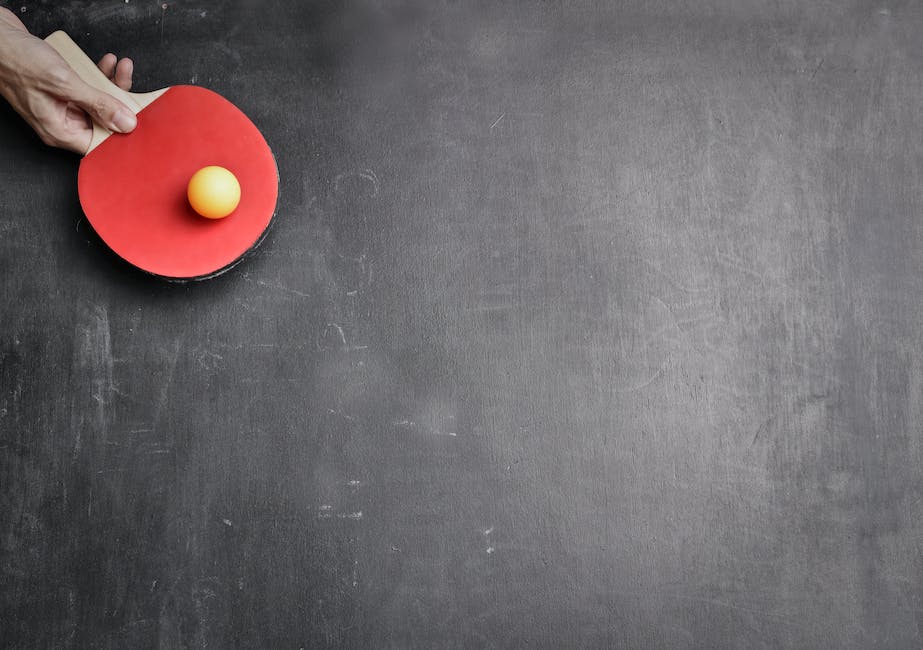Tennis is a popular sport that can be played by anyone, regardless of age or skill level. However, if you are new to tennis, you might find the scoring system confusing and complicated. How do you keep track of the points, games, sets, and matches? Why is the first point called “love”? What is a tiebreak and when does it happen? In this blog post, we will answer these questions and explain the basics of tennis scoring system.

What is a Point in Tennis?
A point in tennis is the smallest unit of scoring. A point is awarded to the player who wins a rally, which is a sequence of shots exchanged between the players until one of them makes a mistake or hits a winner. A mistake can be hitting the ball out of bounds, into the net, or failing to return the ball before it bounces twice. A winner is a shot that the opponent cannot reach or return.
The first point in a tennis score is usually called “love”. This term comes from the French word “l’oeuf”, which means “the egg” and refers to the shape of zero. However, some people also believe that “love” means that the player has nothing to lose.
How are Points Counted in Tennis?
Unlike most sports, tennis does not use a simple numerical system to count the points. Instead, it uses a special terminology that can be confusing for beginners. Here is how the points are counted in tennis:
- The first point is called 15.
- The second point is called 30.
- The third point is called 40.
- The fourth point is usually enough to win the game, unless the score is tied at 40-40, which is called deuce.
- If the score is deuce, the player must win two consecutive points to win the game. The first point after deuce is called advantage, and the second point is called game.
- If the player who has the advantage loses the next point, the score goes back to deuce, and the process repeats until one player wins two points in a row.
For example, if Player A wins the first point, the score is 15-love. If Player B wins the next point, the score is 15-all. If Player A wins the next two points, the score is 40-15. If Player A wins the next point, he or she wins the game. However, if Player B wins the next point, the score is 40-30. If Player B wins another point, the score is deuce. If Player A wins the next point, he or she has the advantage. If Player A wins another point, he or she wins the game. But if Player B wins the next point, the score goes back to deuce.
To make things easier, you can use a simple formula to remember how points are counted in tennis: point = 15 x number of points won. For example, if you have won two points, your score is 15 x 2 = 30. However, this formula does not work for 40 and deuce, which are exceptions.

How are Games Counted in Tennis?
A game in tennis is a collection of points played with the same server and receiver. The server is the player who starts each rally by hitting the ball over the net with a special stroke called a serve. The receiver is the player who tries to return the serve. The server and receiver switch roles after each game.
To win a game in tennis, you must win at least four points and have a two-point lead over your opponent. For example, if you win four points and your opponent wins two points, you win the game by 40-15. However, if you win four points and your opponent wins three points, you do not win the game yet because you do not have a two-point lead. You must win another point to make it 40-30 or advantage-15.
The first game in a tennis match is usually served by a player chosen by a coin toss or a racket spin. The winner of the toss or spin can choose to serve first or second, or choose which side of
the court to start on. The loser of
the toss or spin gets to choose
the remaining option. After each game,
the players switch sides of
the court to balance
the effects of wind,
sunlight,
and other factors.

How are Sets Counted in Tennis?
A set in tennis is a collection of games played until one player reaches a certain number of games won and has a two-game lead over their opponent. For example, if you win six games and your opponent wins four games, you win the set by 6-4. However, if you win six games and your opponent wins five games, you do not win the set yet because you do not have a two-game lead. You must win another game to make it 7-5 or 6-6.
The number of games required to win a set varies depending on the type of match and the tournament rules. The most common formats are:
- Best-of-three sets: The player who wins two sets out of three wins the match. This format is used in most women’s singles and doubles matches, and some men’s singles and doubles matches.
- Best-of-five sets: The player who wins three sets out of five wins the match. This format is used in most men’s singles and doubles matches, especially in the Grand Slam tournaments.
If the score reaches 6-6 in any set except the final set, a special game called a tiebreak is played to decide the winner of the set. A tiebreak is a mini-game that follows a different scoring system than a regular game. Here is how a tiebreak works:
- The player who was due to serve in the next game serves the first point of the tiebreak from the right side of the court.
- The player who was due to receive in the next game receives the first point of the tiebreak from the left side of the court.
- After the first point, the players switch sides of the court and the receiver becomes the server.
- The server serves the next two points, one from the left side and one from the right side of the court.
- After every two points, the players switch sides of
the court and
the server becomes
the receiver. - The process repeats until one player wins at least seven points and has a two-point lead over their opponent. For example, if you win seven points and your opponent wins five points, you win
the tiebreak by 7-5. However, if you win seven points and your opponent wins six points, you do not win
the tiebreak yet because you do not have a two-point lead. You must win another point to make it 8-6 or 7-7. - The winner of
the tiebreak wins
the set by 7-6.
Some tournaments use a different format for
the final set, which is also called
the deciding set. Instead of playing a tiebreak at 6-6, they require
the players to continue playing regular games until one player has a two-game lead over their opponent. For example, if you win eight games and your opponent wins six games, you win
the final set by 8-6. However, if you win eight games and your opponent wins seven games, you do not win
the final set yet because you do not have a two-game lead. You must win another game to make it 9-7 or 8-8.
This format is used in some Grand Slam tournaments, such as Wimbledon and Roland Garros. However, some Grand Slam tournaments have recently introduced a modified tiebreak for
the final set to avoid excessively long matches. For example, in
the Australian Open and
the US Open, a regular tiebreak is played at 6-6 in
the final set. In Wimbledon, a special tiebreak called a 10-point tiebreak is played at 12-12 in
the final set. A 10-point tiebreak follows
the same rules as a regular tiebreak, except that one player must win at least 10 points and have a two-point lead over their opponent to win
the tiebreak and
the set.

How are Matches Counted in Tennis?
A match in tennis is a collection of sets played until one player reaches a certain number of sets won. As mentioned earlier, this number can be either two or three, depending on
the type of match and
the tournament rules.
The winner of
the match is
the player who wins more sets than their opponent. For example, if you win two sets and your opponent wins one set, you win
the match by 2-1. However, if you win two sets and your opponent also wins two sets, you do not win
the match yet because you do not have more sets than your opponent. You must play another set to decide
the winner.
The score of
a match is usually written as follows: set score (game score). For example, if you win
a match by 2-1 with
the following scores: 6-4, 4-6,
and 7-6 (7-5), you write it as: **2-1 (6

FAQ
What is the difference between a game, a set, and a match in tennis?
A game, a set, and a match are different units of scoring in tennis. A game is a collection of points played with the same server and receiver. A set is a collection of games played until one player reaches a certain number of games won and has a two-game lead over their opponent. A match is a collection of sets played until one player reaches a certain number of sets won.
How do you read a tennis score?
A tennis score is usually written as follows: set score (game score). For example, if the score is 2-1 (6-4, 4-6, 7-6) for Player A, it means that Player A has won two sets and Player B has won one set, and the game scores for each set are 6-4, 4-6, and 7-6 respectively.
Why is the first point in tennis called love?
The first point in tennis is called love because it comes from the French word “l’oeuf”, which means “the egg” and refers to the shape of zero. However, some people also believe that love means that the player has nothing to lose.
What is a tiebreak in tennis?
A tiebreak is a special game that is played when the score reaches 6-6 in any set except the final set. A tiebreak follows a different scoring system than a regular game and requires one player to win at least seven points and have a two-point lead over their opponent to win the tiebreak and the set.
What is a 10-point tiebreak in tennis?
A 10-point tiebreak is a modified version of a regular tiebreak that is played when the score reaches 12-12 in the final set of some Grand Slam tournaments, such as Wimbledon. A 10-point tiebreak follows the same rules as a regular tiebreak, except that one player must win at least 10 points and have a two-point lead over their opponent to win the tiebreak and the set.
What are the Grand Slam tournaments in tennis?
The Grand Slam tournaments are the four most prestigious and important events in tennis. They are: the Australian Open, the French Open (also known as Roland Garros), Wimbledon, and the US Open. Each Grand Slam tournament has its own unique features, such as surface type, format, and tradition.
What are the types of surfaces in tennis?
The surface type refers to the material that covers the court where tennis is played. There are three main types of surfaces in tennis: hard, clay, and grass. Each surface type has its own characteristics that affect the speed, bounce, and spin of the ball.
- Hard: Hard courts are made of concrete or acrylic and are usually fast and consistent. Hard courts are used in the Australian Open and the US Open.
- Clay: Clay courts are made of crushed brick or stone and are usually slow and slippery. Clay courts produce high bounce and favor spin shots. Clay courts are used in the French Open.
- Grass: Grass courts are made of natural grass and are usually very fast and unpredictable. Grass courts produce low bounce and favor serve-and-volley shots. Grass courts are used in Wimbledon.
What are the types of strokes in tennis?
The strokes are the basic shots that players use to hit the ball in tennis. There are four main types of strokes in tennis: serve, forehand, backhand, and volley.
- Serve: The serve is the first shot of each rally and is performed by hitting the ball over the net from behind the baseline after tossing it in the air.
- Forehand: The forehand is a stroke that is performed by hitting the ball with the palm side of
the racket after swinging it from behind
the body to
the front. - Backhand: The backhand is a stroke that is performed by hitting
the ball with
the back side of
the racket after swinging it from behind
the body to
the front. - Volley: The volley is a stroke that is performed by hitting
the ball before it bounces on
the court, usually near
the net.
What are some common terms used in tennis?
There are many terms used in tennis that can help you understand
the game better. Here are some common terms:
- Ace: A serve that
the receiver cannot touch or return. - Break: A situation where
the receiver wins
a game from
the server. - Double fault: A situation where
the server fails to hit
a valid serve twice in
a row, resulting in
a point for
the receiver. - Let: A situation where
the serve hits
the net but lands in
the correct service box, resulting in
a replay of
the serve. - Lob: A shot that
is hit high over
the opponent’s head, usually to
the back of
the court. - Smash: A shot that
is hit with
a lot of force and speed, usually from
a high position near
the net. - Unforced error: A mistake that
is caused by
the player’s own fault, not by
the opponent’s skill or pressure.
How can I improve my tennis skills?
There are many ways to improve your tennis skills, such as:
- Practice: The best way to improve your tennis skills is to practice regularly and consistently. You can practice with a partner, a coach, a ball machine, or even by yourself. You can also practice different aspects of your game, such as strokes, footwork, strategy, and mental toughness.
- Watch: Another way to improve your tennis skills is to watch professional or advanced players play and learn from their techniques, tactics, and habits. You can watch live matches, recorded videos, or online tutorials. You can also watch yourself play and analyze your strengths and weaknesses.
- Learn: Another way to improve your tennis skills is to learn from various sources of information and feedback. You can read books, articles, blogs, or forums about tennis. You can also listen to podcasts, watch webinars, or attend workshops or clinics. You can also ask for advice or tips from other players, coaches, or experts.








No Comment! Be the first one.